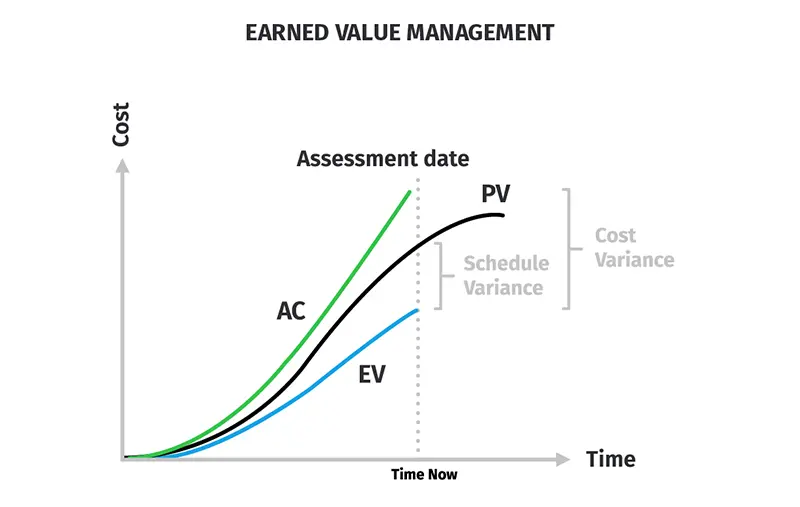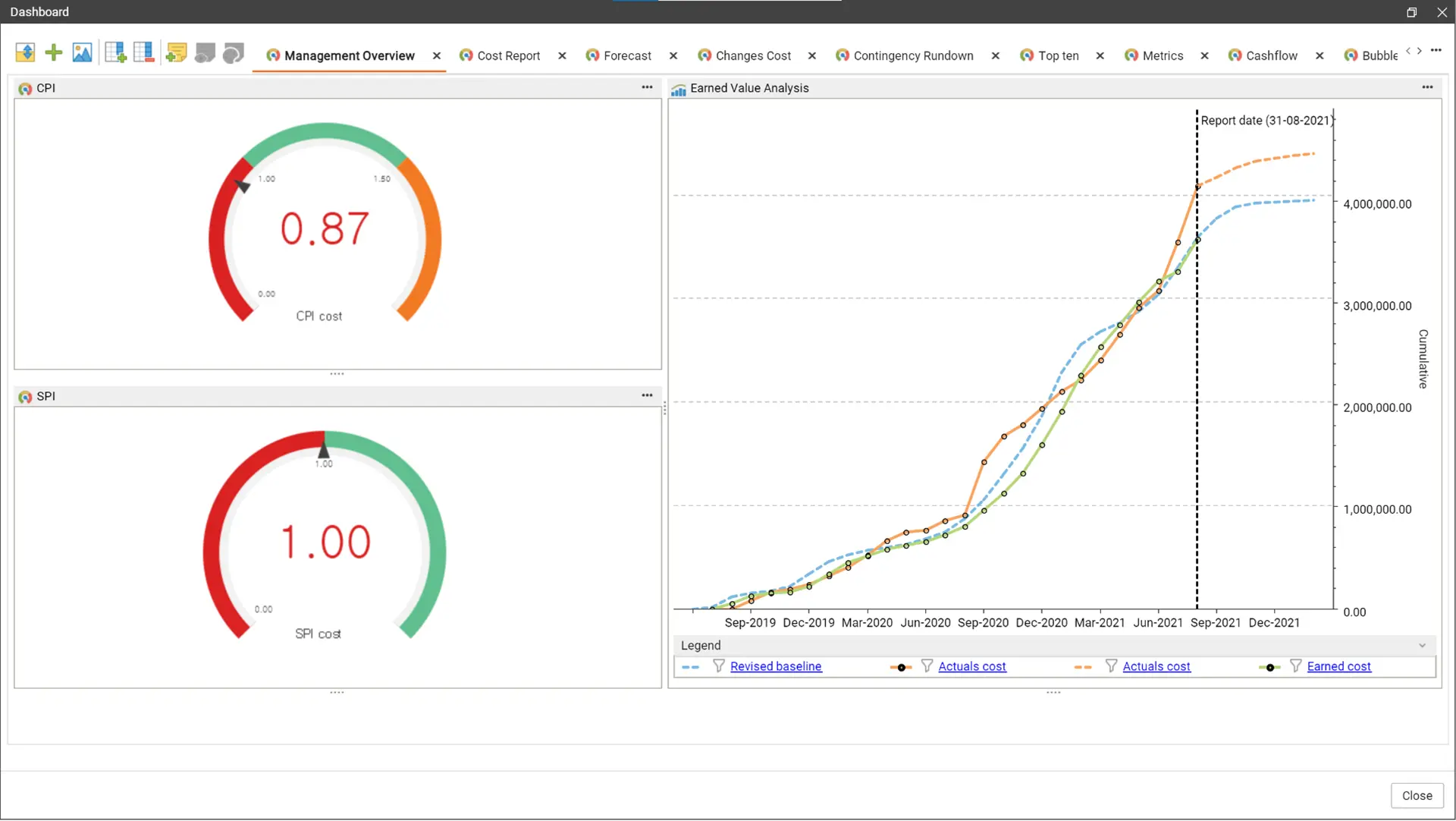Scope creep, budget constraints, and aligning actual work with planned tasks are just a few of the challenges faced by project managers. Ever wondered how amid these obstacles project managers keep track of progress effectively? Earned Value Management (EVM) is their not-so-secret weapon. Understanding EVM’s significance is crucial; it not only keeps projects on course but also provides a comprehensive snapshot of their health.
In this guide, we explore what Earned Value Management (EVM) is, delve into its core principles, and uncover its pivotal role in enhancing project performance. We’ll also highlight how tools like project controls software can help simplify and streamline the implementation of EVM practices.
Table of Contents
- What is Earned Value Management (EVM)?
- EVM formulas and core concepts
- What are benefits of Earned Value Management in Project Management?
- Implementing Earned Value Management (EVM): A Step-by-Step Guide
- Mastering Effective Project Management with Earned Value Management software
- Benefits of Using Earned Value Management Software in Project Management
What is Earned Value Management (EVM)?
In the project management field, Earned Value Management is a project management technique that aligns schedule, costs, and scope for effective project progress assessment. It offers a holistic view, moving beyond mere schedule and budget tracking.
Earned Value Analysis (EVA) plays a pivotal role in EVM and project management. It enables project managers to quantitatively evaluate the project’s progress based on the work completed. It does so by comparing planned work progress and budget against the actual costs incurred.
EVA and EVM are interconnected yet distinct components within project management. EVM extends EVA’s scope, offering a broader perspective for informed decision-making. While EVA focuses on progress evaluation specifics, EVM conducts comprehensive trend analysis and forecasting using the project’s derived data. It’s a multifaceted function merging data analysis with strategic decision-making.
Similarly, Earned Value Management Systems (EVMS) act as a suite of software, tools, templates, and processes designed to streamline EVM practices within projects. Earned Value Management Systems serve as a cohesive platform, facilitating a seamless and integrated approach to track, analyze, and forecast project metrics effectively.
Therefore, combining EVA’s quantitative evaluation, EVMS’s streamlined processes, and EVM’s comprehensive approach equips project managers with the necessary tools to accurately assess progress, efficiently manage resources, and make informed decisions. This synergy enables proactive adjustments, ensuring successful project delivery.
Earned Value Management formulas and core concepts
Earned Value Management (EVM) encompasses a set of fundamental concepts that provide project managers with a comprehensive understanding of a project’s performance, costs, and schedule adherence.
Planned Value (PV)
At the heart of Earned Value Management lies the concept of Planned Value (PV), also known as the Budgeted Cost of Work Scheduled (BCWS). PV represents the authorized budget assigned to scheduled work, outlining what should be spent based on the project plan and schedule.
Planned Value (PV)=Total Project Budget × Percentage of Work Scheduled
Actual Cost (AC)
Actual Cost (AC), referred to as the Actual Cost of Work Performed (ACWP), represents the total cost incurred for the work completed up to a certain period. It corresponds to the actual expenses of the resources used to accomplish the work.
It includes various project-related costs like labor, materials, equipment, and overhead expenses. Notably, AC is vital for comparing actual expenditures with the budgeted costs (PV and EV) and identify potential cost overruns or underruns.
Actual Cost (AC)=Total expenses incurred for the project, for the work completed
Earned Value (EV)
Earned Value (EV), or the Budgeted Cost of Work Performed (BCWP), marks the value of completed work at a specific point in time. It provides valuable insights into the efficiency and progress of the work completed compared to what was initially planned. Thus, analyzing Earned Value enables project managers to evaluate if the project is on track, ahead, or lagging behind schedule.
Earned Value (EV)=Total Project Budget × Percentage of Work Completed
- EV=PV: The project is on schedule
- EV=AC: The project is on budget

Figure 1: Four examples of curves that describe the Planned (PV), Earned (EV) and Actual (AC) costs of an example project.
Variance Analysis
Planned value, actual cost, and earned value metrics are essential for variance calculations. Schedule and cost variances (SV and CV) play pivotal roles in EVM, revealing how projects deviate from the baseline. Analyzing these variances allows project managers to assess schedule adherence, cost performance, and make informed decisions for timely adjustments.
Cost Variance (CV)
Cost Variance (CV) refers to the variance between the Earned Value (EV) and the Actual Cost (AC). Simply put, it indicates the discrepancy from the planned initial budget. A positive CV indicates that the project is under budget, while a negative CV indicates cost overruns.
Cost Variance (CV)=Earned Value (EV) −Actual Cost (AC)
Schedule Variance (SV)
Schedule Variance (SV) portrays the variance between the Earned Value (EV) and the Planned Value (PV). Simply put, it corresponds to the deviation from the initially planned schedule. A positive SV indicates that the project is ahead of schedule, whereas a negative SV indicates delays in the project timeline.
Schedule Variance (SV)=Earned Value (EV)−Planned Value (PV)

Figure 2: Example project showing the cost- and schedule variance based on comparing the earned value to the actual and planned cost. Note that actual cost is not to be compared directly to the planned cost.
Performance Indexes
In addition to variance analysis, project performance evaluation often incorporates two critical parameters: the Schedule Performance Index (SPI) and the Cost Performance Index (CPI). Unlike traditional variance analysis, these indexes present a nuanced view of project progress and resource utilization, enhancing the project manager’s ability to assess and steer the project towards successful outcomes.
Cost Performance Index (CPI)
The Cost Performance Index (CPI) represents the cost efficiency and financial effectiveness of a project by measuring the ratio of EV to AC.
Cost Performance Index (CPI)= Earned value (EV)/ Actual Cost (AC)
- CPI > 1: indicates the project is under budget and is achieving results with less than the allocated budget.
- CPI = 1: indicates the project is performing exactly on budget.
- CPI < 1: Indicates the project is over the budget, suggesting that more resources are being burned than expected. Corrective actions should be taken.
Schedule Performance Index (SPI)
Similarly, the Schedule Performance Index (SPI) measures efficiency from a schedule perspective by comparing EV to PV.
Schedule Performance Index (SPI)=Earned Value (EV)/ Planned Value (PV)
Interpretation of SPI:
- SPI > 1: Indicates that the project is ahead of schedule, achieving more work than scheduled within a given time frame.
- SPI = 1: Demonstrates that the project is precisely adhering to the planned schedule.
- SPI < 1: Suggests that the project is behind schedule, achieving less work than scheduled within a given time frame.
What are benefits of Earned Value Management in Project Management?
Tracking Project Performance
Earned Value Management (EVM) efficiently evaluates a project’s performance by analyzing planned value (PV), earned value (EV), and actual cost (AC). It’s a robust tool that holds team members and stakeholders accountable, facilitates early issue identification, and allows timely interventions to address any deviations from the project plan.
Efficient Cost and Schedule Oversight
Earned Value Management plays a vital role in predicting final costs and timelines. This empowers decision-makers to allocate resources judiciously, adjust schedules when necessary, and refine project scopes. By aligning closely with cost management practices, EVM ensures financial efficiency and helps keep the project within budget.
Facilitating Clear Communication
EVM acts as a powerful communication tool, offering transparent insights into project status, risks, and essential steps for successful completion. This transparency fosters better collaboration and understanding among project stakeholders.
Proactive Risk Management
EVM serves as a proactive tool in risk management by identifying potential deviations in PV, EV, and AC. This early identification enables swift action to mitigate emerging risks before they escalate, contributing to more favorable project outcomes.
Optimizing Resource Utilization
Precise comparison between planned work and actual progress and costs is where Earned Value Management shines. This meticulous analysis allows for accurate adjustments in resource allocation, ensuring resources align seamlessly with project needs, minimizing wastage, and maximizing efficiency for project success.
Data-Driven Decision-Making
Leveraging EVM provides a data-driven approach that enables accurate forecasting by scrutinizing PV, EV, and AC values. This data empowers project managers to make informed decisions, strategize adjustments, prioritize tasks, and allocate resources effectively based on real-time insights.
Implementing Earned Value Management (EVM): A Step-by-Step Guide
1) Define Project Scope and Objectives
To ensure a project starts off on the right foot, it’s crucial to define its scope and objectives clearly. This involves breaking down complex deliverables into manageable parts through a Work Breakdown Structure (WBS). This detailed breakdown provides a clear understanding of the project’s scope and helps define tasks efficiently.
When organizing the project, two additional project breakdown structures come into play:
- Organization Breakdown Structure (OBS): The OBS functions as a framework within the project, facilitating the identification of responsibilities, accountabilities, and managerial oversight for all authorized work scope. This allows the scope to be broken down into the various contributing parties or project team members.
- Responsibility Assignment Matrix (RAM): By linking the WBS and OBS, a RAM is formed. This matrix clearly outlines who holds responsibility for each task, ensuring a well-defined ownership structure for every project segment. This allows handing out the work to specific parties and following up on the progress of that work during execution.
2) Planning, Scheduling, and Budgeting
A detailed project plan covering schedules, budgets, and milestones is crucial. Key steps:
- Budget Allocation to Work Packages: Assign a Planned Value (PV) to each work package, aligning it with estimated completion costs. Whether in time or financial terms, this allocation should establish a robust budgetary framework for individual project segments. This budget allocation typically follows a Cost Breakdown Structure (CBS), which organizes costs into manageable components.
- Strategic Project Scheduling: Develop a detailed project schedule outlining the anticipated completion timelines for every work package or task. This comprehensive schedule should serve as a strategic blueprint, determining milestones and guiding progress tracking.
3) Progress Tracking Mechanisms
Implement robust methods for tracking progress within each work package or task. Define metrics and measurement tools that effectively monitor actual progress against the anticipated completion timelines set in the project schedule. These mechanisms serve as vital checkpoints for real-time project evaluation and adjustments, playing a pivotal role in determining Earned Value.
4) Track Progress and Actual Costs with Earned Value Management Software
Record the Actual Costs accumulated for each work package as the project advances. This corresponds to expenses related to labor, materials, equipment, as well as additional expenditures.
To assess project performance, calculate the Earned Value utilizing various methods tailored to different project contexts:
- 0/100 Rule: Allocate 100% EV upon task completion.
- 50/50 Rule: Attribute 50% EV at task initiation and the remaining 50% upon completion.
- Weighted Milestone: Assign EV based on significant project milestones.
5) Analyze Performance Metrics
Compute CV and SV to assess deviations from the budget and schedule. Additionally, use CPI and SPI to gain insights into cost and schedule efficiencies.
Analyzing these cost control KPIs empowers project managers to detect potential issues in budget and schedule adherence, allowing for prompt corrective actions.
6) Take Action and Communicate
Based on the EVM analysis, take corrective actions. Especially, when variances exceed predetermined thresholds. This may involve adjusting schedules, reallocating resources, or revising project scopes as necessary. Simultaneously, ensure transparent communication of project progress to stakeholders through regular project reports and meetings.
7) Review, Update Data, and Improve
Throughout the project, ensure consistent updates to EV, AC, and PV values to reflect the current project status. This ongoing data maintenance is essential for ensuring the accuracy of Earned Value Management metrics and facilitating informed decision-making.
While it is crucial to regularly review and update Earned Value Management metrics, it is unnecessary to revise the project’s baseline for every minor change. Reserve baseline revisions for significant authorized alterations in project scope, cost, or schedule, or during notable fluctuations in rates like currency exchanges or resource rates.
Upon project completion, conduct a comprehensive review to assess the effectiveness of EVM implementation. Include in your close-out report the key lessons learned and identified areas for improvement to enhance future project implementations.
Mastering Effective Project Management with Earned Value Management software

With earned value management software, teams can easily integrate cost, schedule, and scope data for projects. This provides project managers with real-time insights to detect deviations early, make informed adjustments, and report on project health to stakeholders. Furthermore, by automating data collection, calculations, and reporting, EVM software reduces the risk of human error and frees up project managers to focus on analyzing results rather than crunching numbers.
Benefits of Using Earned Value Management Software in Project Management
Implementing EVM with the right software unlocks significant benefits for project teams:
- Enhanced tracking and project visibility: EVM software automates the capture and comparison of planned, earned, and actual values, reducing human error. By providing a consolidated view of performance across scope, cost, and schedule, it strengthens visibility and control over the entire project lifecycle.
- Data-driven decision-making: By leveraging real-time dashboards and standardized reports, project managers can quickly compare actual progress with planned benchmarks. This makes it easier to identify variances and potential risks before they escalate. Furthermore, sharing consistent, up-to-date information improves transparency, accountability, and collaboration among stakeholders.
- Forecasting accuracy: Advanced CPI and SPI-based forecasting enables predictive analysis of future cost and schedule outcomes. This allows teams to plan strategically, anticipate risks, and prevent overruns or delays.
By combining these benefits, EVM software empowers project teams to work more efficiently, make informed decisions, and proactively manage risks. This ensures better outcomes across all project phases.
Top Features of Earned Value Management Software
When evaluating earned value management software, project professionals should focus on features that truly elevate project control and decision-making:
- KPI dashboards: Visual overviews should highlight cost and schedule performance at a glance to rapidly identify issues.
- Customizable reports: Look for flexible reporting tools that present EVM metrics in formats tailored to project sponsors, executives, or field teams, ensuring transparency and accountability.
- Robust budget snapshots: Budget snapshots provide a real-time view of how the budget has changed over time. This makes monitoring cost deviations more efficient and helps align costs with project progress to prevent budget overruns.
- Cost & schedule data integration: Seamless synchronization with scheduling tools (like Primavera or MS Project) and cost systems to maintain a single source of truth.
- Trend, variance, and forecast analysis: Built-in analytics to evaluate historical performance, pinpoint deviations, and forecast future outcomes for proactive decision-making.
- Scalable architecture: The ability to manage small projects or large multi-billion-dollar portfolios within the same system.
Together, these features enable project managers to maintain full visibility, streamline decision-making, and keep projects on time and within budget.
Cleopatra’s Earned Value Management Software

Cleopatra Enterprise stands out as a comprehensive solution for organizations seeking to implement earned value management effectively. Designed to simplify project controls, Cleopatra provides project managers with real-time insights into performance, enabling proactive decision-making and resource optimization.
With Cleopatra Enterprise, project teams can:
- Automatically calculate key EVM metrics such as SPI, CPI, EV, and PV, keeping performance data accurate and up-to-date.
- Visualize trends and project progress using dynamic dashboards, earned value charts, and S-curves for clear, actionable insights.
- Integrate cost, schedule, and scope data seamlessly to get a consolidated view of project health.
- Standardize reporting across teams and projects, ensuring stakeholders receive consistent and transparent updates.
By using Cleopatra Enterprise project controls software, organizations gain full visibility into project performance, detect issues early, and take corrective actions before they affect schedule or budget.
This guide will walk you through the critical aspects of cost estimation, including key principles, the importance of…
Project metrics and benchmarking provide a powerful way of measuring the performance and health of your project. They…
Related resources
Cracking the Cost Performance Index (CPI)
Understanding the health of your project is at the heart of effective project management. The Cost Performance Index (CPI) stands as a beacon, guiding project management decisions worldwide.
Read blog article
A Schedule Performance Index (SPI) Guide
The Schedule Performance Index (SPI) is one of the most powerful metrics in Earned Value Management (EVM) to measure your project’s schedule efficiency objectively. Whether you’re managing a billion-dollar infrastructure project or a smaller project, SPI can give you clear, data-driven insights to timely steer your project in the right…
Read blog article